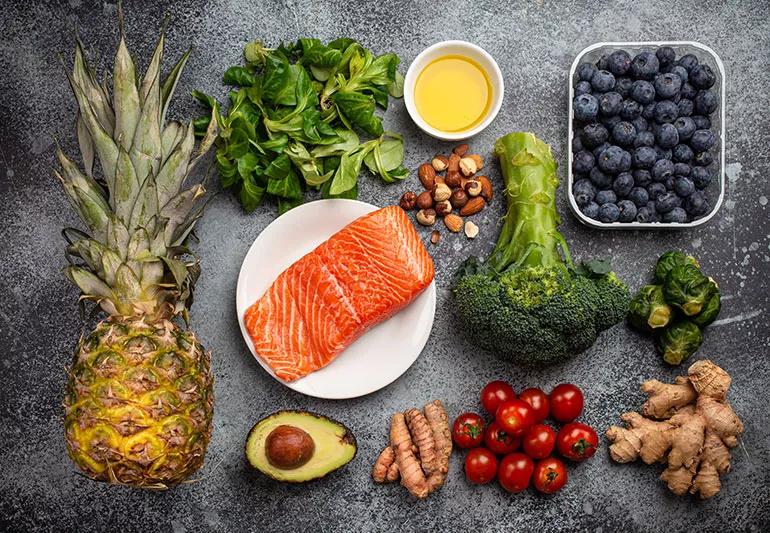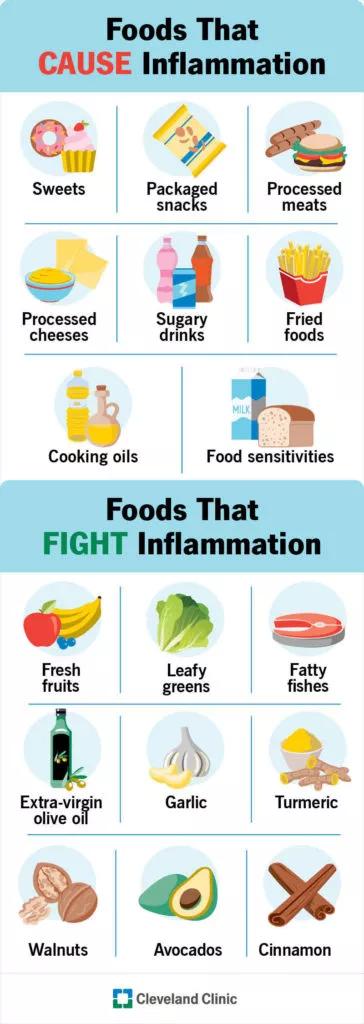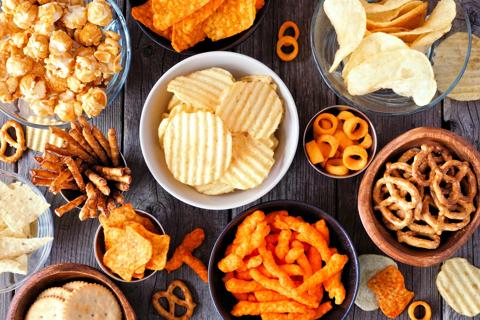The foods you eat (and avoid) impact inflammation inside of your body

You cut your finger, and it becomes red and inflamed. You hurt your knee, and it gets swollen and inflamed. But what, exactly, does inflammation mean for your insides?
Advertisement
Cleveland Clinic is a non-profit academic medical center. Advertising on our site helps support our mission. We do not endorse non-Cleveland Clinic products or services. Policy
A little bit of inflammation contributes to healing, but when inflammation becomes chronic, it can trigger disease processes. Chronic inflammation can damage your heart, brain and other organs, and it plays a role in nearly every major illness, including cancer, heart disease, Alzheimer’s disease and depression.
“Just like inflammation happens after an injury, that same process can happen within your body,” says registered dietitian Julia Zumpano, RD, LD. “Certain foods and health conditions can cause inflammation.”
But the food we eat — and don’t eat — can soothe and even prevent that inflammation. Zumpano explains the health benefits of an anti-inflammatory diet, as well as where to start, what to stop eating and how to tell if it’s working.
Everyone’s inflammatory triggers are different, so there are a few reasons you might experience inflammation. Zumpano delves deeper.
If you’re living with a chronic health condition, you may be living with chronic inflammation, too. Conditions associated with inflammation include:
Advertisement
“We know of some general associations,” Zumpano says. “Refined starches and processed meats are not good for people with heart disease (or anyone); gluten and dairy can further inflame bowel disorders; and nightshades can be inflammatory for arthritis. But each person needs to find their personal triggers.”
Even if you don’t have a chronic condition, you can experience inflammation when you eat foods that you’re sensitive to.
“When you have an immune response to a food, your antibodies rise, which can cause inflammation,” Zumpano explains. “Your body basically sees that food as a foreign body and starts working against it.”
But foods that cause inflammation in one person might not cause it in others — the way, for example, that you can enjoy the occasional slice of pizza without issue, while doing so causes severe inflammation in your friend who has a gluten sensitivity.
It’s not a perfect example, though! Keep in mind that although you may not experience a physical sign of inflammation, all processed foods can lead to internal inflammation. So, keep them to a minimum, even if you don’t have a particular sensitivity.
This is a tricky one! You might not even realize you’re experiencing this type of hidden inflammation within your body, although some physical signs can clue you into it.
“You could have redness, puffiness, skin rashes, swelling in your hands and feet,” she says. “You can also experience abdominal distention, when your pants feel tight around your waist.”
Other clues can include fatigue, weight gain, achy joints and muscles, headaches and gastrointestinal issues. You may also be more prone to getting colds and the flu, and when you do get them, they may linger for weeks.
The foods you eat (and the ones you avoid) can help soothe and even prevent inflammation by quashing your body’s inflammatory responses. But because everyone’s inflammatory triggers are different, there’s no one-size-fits-all anti-inflammatory diet.
“The term ‘anti-inflammatory diet’ doesn’t refer to a specific diet regimen but to an overall style of eating,” Zumpano says. But there are some guidelines to follow to eat in a way that reduces the likelihood of inflammation.
The first key to minimizing inflammation is cutting foods that cause it. “An anti-inflammatory diet is one that includes minimally processed foods,” Zumpano says. “That typically means staying away from anything that comes in a box or a bag, or anything that has a laundry list of ingredients — especially if they start with sugar, salt or a processed oil and include ingredients you don’t recognize.”
Advertisement
Examples include:
Even so-called healthy snacks like granola bars, trail mix and baked chips can have a lot of processed ingredients, including added sodium and sugar.
“There’s no real nutritional benefit to them, so you’re not lacking anything when you cut them out,” Zumpano says.
When you’ve cut out the processed stuff, what’s left? Whole foods, of course!
“A whole food is a one-ingredient food, an entire entity: an apple, an orange, a cucumber,” Zumpano says. In addition to fruits and vegetables, other examples include:
In short, if you can find it in nature, it’s probably a whole food.
So do any processed foods make the grade? “Foods that have more than one ingredient can still be made up of whole foods — for example, store-bought hummus, dried fruit and nut snack mix or a pasta sauce,” Zumpano says. “The key is to always review the ingredient list.”
Advertisement
That means choosing breads and pastas that are minimally processed, minimally preserved and made with whole grains.
Again, there’s no one-size-fits-all anti-inflammatory diet. But two styles of eating have been shown to help: the Mediterranean diet and the DASH diet.
“Positive research reports that these diets are successful in reducing inflammation, as well as cholesterol, weight, blood pressure and blood sugar,” Zumpano says. She explains both of them.
Thought to be the heart-healthiest of diets, the Mediterranean diet is a style of eating popular among people who live along the Mediterranean Sea. A foundation of this diet is fish high in omega-3 fatty acid, which has been proven to reduce inflammation.
“The Mediterranean diet has been shown to be anti-inflammatory because of its focus on whole foods and omega-3 fatty acids,” Zumpano says. “It also eliminates processed oils, like cottonseed and soybean oil, which are found in many ultra-processed foods.”
DASH, which stands for Dietary Approaches to Stop Hypertension, is a diet designed to reduce high blood pressure. “This diet has been shown to reduce inflammation, probably because it reduces blood pressure and promotes weight loss,” Zumpano notes. Remember, both high blood pressure and obesity are associated with inflammation.
Advertisement
Like the Mediterranean diet, the DASH diet focuses on whole foods and limits protein, sweets and processed foods. But DASH includes a bit more dairy, and it doesn’t specifically encourage fish or extra-virgin olive oil.
Though meat can be inflammatory, keep in mind that cutting animal products doesn’t necessarily mean eating healthfully.
“Eating a plant-based diet can help suppress inflammation,” Zumpano says, “but vegetarian, pescatarian and even vegan diets can still include foods like potato chips, fries and cookies. To see anti-inflammatory benefits, you have to stick to whole foods.”
If you’ve cut out processed foods but still experience symptoms of inflammation, you may need to go a step further.
“Finding the right anti-inflammatory diet for you is a matter of personalization and finding the foods that trigger your inflammation,” Zumpano explains. The best way to start is by trying an elimination diet and slowly cutting out potential trigger foods one by one.
Food sensitivity tests can help identify which foods increase your body’s antibody response, too, which may be helpful if you can’t seem to determine a culprit on your own.
The biggest hint that your anti-inflammatory diet is working is if you start feeling better, so keep an eye on your symptoms and look for positive changes to your health.
“There are a lot of different ways your body can react to an anti-inflammatory diet,” Zumpano says. They include:
Starting an anti-inflammatory diet isn’t a magic pill. Your results will vary based on the severity of your intolerance and inflammation.
“Drastic changes never lead to long-term success, so give yourself three to six months to make diet changes and to begin to see results,” Zumpano advises. “Begin by making small changes that you know will be impactful, and then slowly continue to add on.”
In some cases, if you significantly react to a certain food, you may see results as soon as two to three weeks after eliminating that food from your diet.
“This can be very encouraging and motivating,” Zumpano says. “Patients often tell me that they never realized how bad they felt until they changed their diet and began to feel so much better.”

Learn more about our editorial process.
Advertisement

Cut back on foods made with added sugars, trans fats, refined carbs, omega-6 fatty acids and processed meats

Foods and supplements that support your body

The flexible eating plan aims to boost your brain health by focusing on plant-based foods and limiting saturated fat

Some diets shun them, but research hasn’t concluded that they’re harmful

With a focus on internal cues for hunger and fullness, this eating style may revolutionize your relationship with food

Eat this fatty fish two times a week to support your muscle, brain and heart health

Designed to lower your blood pressure, this eating plan focuses on heart-healthy foods like whole grains, fruits and vegetables

Eating well can help reduce inflammation when you have endometriosis

If you’re feeling short of breath, sleep can be tough — propping yourself up or sleeping on your side may help

If you fear the unknown or find yourself needing reassurance often, you may identify with this attachment style

If you’re looking to boost your gut health, it’s better to get fiber from whole foods